 W
WThe Abduction of Ganymede is a 1635 oil painting of Ganymede by the Dutch Golden Age painter Rembrandt in the collection of the Staatliche Kunstsammlungen Dresden.
 W
WThe Adoration of the Shepherds, is a c. 1515–1520 oil on panel painting of the Nativity by the German artist Lucas Cranach the Elder in the collection of the Gemäldegalerie Alte Meister in Dresden.
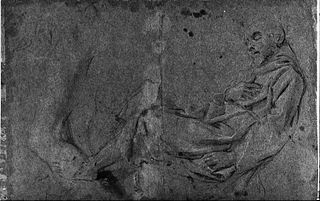 W
WThe Death of Saint Francis is the probable subject of two lost paintings by Annibale Carracci, both possibly dating to 1597-1598. One is known solely through a print and the other through a series of painted copies.
 W
WThe Deliverance of Arsinoe is a 1555-56 painting by Tintoretto, now in the Gemäldegalerie Alte Meister in Dresden. It shows Arsinoe IV of Egypt fleeing from Alexandria after Julius Caesar arrived in the city in 48 BC and sided with Arsinoe's half-sister Cleopatra.
 W
WDon Juan Mateos is an oil on canvas painting widely attributed to Diego Velázquez created circa 1632–3.
 W
WThe Dresden Altarpiece is a triptych by German Renaissance artists Albrecht Dürer, executed between 1496 and 1497, and perhaps continued in 1503–1504. It is housed in the Gemäldegalerie Alte Meister of Dresden, Germany.
 W
WDresden From the Right Bank of the Elbe Above the Augustus Bridge is an oil on canvas by the Italian urban landscape painter Bernardo Bellotto. Painted in 1747, it depicts the view of Dresden from the right bank of the River Elbe, including the Dresden Frauenkirche, the Dresden Cathedral, and the Augustus Bridge. One year later, he painted another piece titled Dresden From the Right Bank of the Elbe Below the Augustus Bridge, looking in the other direction from below the Augustus Bridge. Both of the paintings are in the permanent collection of the Gemäldegalerie Alte Meister. The paintings have proved invaluable in rebuilding parts of the city that were destroyed during World War II.
 W
WDresden From the Right Bank of the Elbe Below the Augustus Bridge is an oil on canvas by the Italian urban landscape painter Bernardo Bellotto. Painted in 1748, it depicts the view of Dresden from the right bank of the River Elbe, including the Dresden Frauenkirche, the Dresden Cathedral, and the Augustus Bridge. One year earlier, he painted another piece titled Dresden From the Right Bank of the Elbe Above the Augustus Bridge, looking in the other direction from above the Augustus Bridge. Both of the paintings are in the permanent collection of the Gemäldegalerie Alte Meister. The paintings have proved invaluable in rebuilding parts of the city that were destroyed during the World War II.
 W
WThe Dresden Triptych is a very small hinged-triptych altarpiece by the Early Netherlandish painter Jan van Eyck. It consists of five individual panel paintings: a central inner panel, and two double-sided wings. It is signed and dated 1437, and in the permanent collection of the Gemäldegalerie Alte Meister, Dresden, with the panels still in their original frames. The only extant triptych attributed to van Eyck, and the only non-portrait signed with his personal motto, ALC IXH XAN. the triptych can be placed at the midpoint of his known works. It echoes a number of the motifs of his earlier works while marking an advancement in his ability in handling depth of space, and establishes iconographic elements of Marian portraiture that were to become widespread by the latter half of the 15th century. Elisabeth Dhanens describes it as "the most charming, delicate and appealing work by Jan van Eyck that has survived".
 W
WDrunken Silenus is a 1620 painting by Anthony van Dyck, now in the Gemäldegalerie Alte Meister in Dresden.
 W
WThe Finding of Moses is an oil on canvas painting by Paolo Veronese, now in the Gemäldegalerie Alte Meister in Dresden and measuring 178 by 277 cm. It is one of at least eight works on the finding of Moses by him and his studio - another now in Lyon is thought to be the preparatory sketch for the Dresden work.
 W
WGirl Reading a Letter at an Open Window is an oil painting by Dutch Golden Age painter Johannes Vermeer. Completed in approximately 1657–59, the painting is on display at the Gemäldegalerie in Dresden. For many years, the attribution of the painting—which features a young Dutch woman reading a letter before an open window—was lost, with first Rembrandt and then Pieter de Hooch being credited for the work before it was properly identified in 1880. After World War II, the painting was briefly in possession of the Soviet Union. Apparently well-preserved, the painting may have been altered after the painter's death.
 W
WHealing of the Man Born Blind is a painting of the healing of the man born blind by El Greco, produced in 1567 during his time in Venice. It is now in the Gemäldegalerie Alte Meister in Dresden.
 W
WThe Holy Family with Saints Anne and John the Baptist is a tempera on canvas painting by Andrea Mantegna, dating to 1495-1500. It measures 75.5 cm by 61.5 cm and is now in the Gemäldegalerie in Dresden.
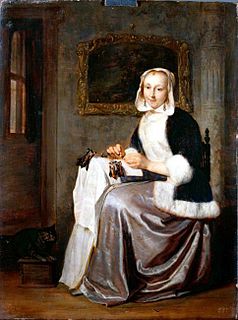 W
WThe Lace-Maker is an oil on canvas painting by the Dutch painter Gabriël Metsu. It is an example of Dutch Golden Age painting and is part of the collection of Gemäldegalerie Alte Meister.
 W
WThe Lion and Leopard Hunt or The Lion Hunt is a painting by Peter Paul Rubens, now held in the Gemäldegalerie Alte Meister in Dresden, Germany. It is very similar to his The Tiger Hunt from the Museum of Fine Arts of Rennes and its dating is debated.
 W
WLot and His Daughters is a 1622 oil on canvas painting of Lot and his daughters by Orazio Gentileschi, now in the Gemäldegalerie, Berlin.
 W
WMadonna and Child with Saint George is an oil on panel painting by Correggio dating to around 1530 and now in the Gemäldegalerie in Dresden.
 W
WMadonna and Child with Saints is a 1588 oil on canvas painting by Annibale Carracci, now in the Gemäldegalerie Alte Meister in Dresden. Signed and dated by the artist, it is also known as Madonna and Child with Saints Francis, Matthew and John the Baptist, Madonna and Child Enthroned with Saint Matthew and the St Matthew Madonna.
 W
WMadonna and Child with St Francis or Madonna of St Francis is a 1514-1515 painting by Correggio, now held in the Gemäldegalerie Alte Meister in Dresden, Germany. It shows Francis of Assisi, with the stigmata, prostrating himself before an enthroned Madonna and Child - the work's theme is the intercession of the Madonna, which was promoted by the Franciscans after the definition of the dogma of the Immaculate Conception in 1473. Francis is supported by Anthony of Padua, whilst on the right are Catherine of Alexandria and John the Baptist and on the base of the Madonna's throne is a small grisaille image of Moses with the tablets of the law. Catherine's wheel bears the painter's signature "Antonivs de Alegri F.[ecit]".
 W
WMercury and Argus is an oil on panel painting by the Flemish artist Peter Paul Rubens. It was created between 1635 and 1638 and is now in the possession of the Gemäldegalerie Alte Meister, Dresden, Germany. Another work on the same theme and with the same title, painted on canvas by Rubens between 1636 and 1638, is in the collection of the Prado Museum, Madrid.
 W
WMystic Marriage of Saint Catherine of Alexandria is a oil on panel painting of the sacra conversazione genre by Andrea del Sarto, executed c. 1512-1513. It was acquired by the imperial gallery in Prague in 1749 and now is in the Gemäldegalerie in Dresden.
 W
WThe Nativity is a painting finished around 1529–1530 by the Italian painter Antonio da Correggio. It is housed in the Gemäldegalerie Alte Meister, Dresden.
 W
WPortrait of Baudouin de Lannoy is a small oil-on panel portrait by the Early Netherlandish painter Jan van Eyck, completed c. 1435. It shows Baldwin of Lannoy, a contemporary Flemish statesman and ambassador for Philip the Good at the court of Henry V of England. From surviving documents it is known that the work was commissioned to mark his entry into the order Baudouin de Lanno. He is in a formal pose, holding a wooden stick in his right hand, and a gold ring on his little finger. Van Eyck's surviving early portraits typically show the sitter holding an emblem of his profession and class.
 W
WThe Portrait of Bernhart von Reesen is a portrait painting by German Renaissance master Albrecht Dürer. It depicts a man wearing a beret and holding a piece of paper against a red background. The oil on panel painting is dated 1521 and is in the collection of the Gemäldegalerie Alte Meister of Dresden, Germany.
 W
WThe Portrait of Henry IV of Saxony and Catherine of Mecklenburg are a matching pair of full-length portrait paintings by the German Renaissance master Lucas Cranach the Elder, dating from 1514, now in the Gemäldegalerie Alte Meister, Dresden, Germany.
 W
WThe Presentation of the Virgin Mary at the Temple is a painting by the Italian Renaissance master Cima da Conegliano, c. 1496–1497, in the Gemäldegalerie Alte Meister of Dresden, Germany, of the Presentation of Mary. The work presents the theme, apocryphal, but common in Christian art, of the presentation of the Virgin Mary in the Temple of Jerusalem, during her childhood.
 W
WThe Procuress is a 1656 oil-on-canvas painting by the then 24-year-old Johannes Vermeer. It can be seen in the Gemäldegalerie Alte Meister in Dresden. It is his first genre painting and shows a scene of contemporary life, an image of mercenary love perhaps in a brothel. It differs from his earlier biblical and mythological scenes. It is one of only three paintings Vermeer signed and dated. In 1696 the painting, being sold on an auction in Amsterdam, was named "A merry company in a room".
 W
WThe Prodigal Son in the Brothel or The Prodigal Son in the Tavern or Rembrandt and Saskia in the parable of the prodigal son is a painting by the Dutch master Rembrandt. It is housed in the Gemäldegalerie Alte Meister of Dresden, Germany. It is signed "REMBRANDT F.".
 W
WSacrifice of Isaac refers to a work by Andrea del Sarto, existing in three versions at the Gemäldegalerie Alte Meister in Dresden, the Cleveland Museum of Art and the Museo del Prado.
 W
WSaint Roch Giving Alms is an oil on canvas painting by Annibale Carraci, commissioned between 1587 and 1588 by the Confraternity of San Rocco in Reggio Emilia, a body for whom he produced several works. His largest work on panel or canvas, it is the crowning achievement of his career before his move to Rome. Only completed in 1595, it is now in the Gemäldegalerie Alte Meister in Dresden, Germany.
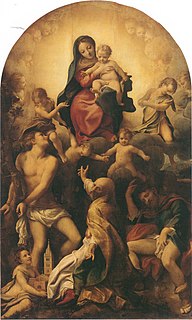 W
WThe San Sebastiano Madonna is an oil on canvas painting by Correggio, dating to around 1524 and now in the Gemäldegalerie Alte Meister in Dresden. It measures 265 by 161 cm.
 W
WScenes from the Life of Saint Zenobius is a series of paintings by the Italian Renaissance artist Sandro Botticelli. Four panels from the series survive, which are now in three different museums. Each depicts three or more incidents from the life of Zenobius, an early Bishop of Florence who perhaps died in 417. The works are all in tempera on wood, and around 66 cm (26 in) high, though their length varies rather more, from about 149 to 182 cm.
 W
WThe Seven Sorrows Polyptych is an oil on panel painting by Albrecht Dürer. The painting includes a central picture, currently at the Alte Pinakothek in Munich, and seven surrounding panels which are exhibited at the Gemäldegalerie Alte Meister of Dresden.
 W
WThe Sistine Madonna, also called the Madonna di San Sisto, is an oil painting by the Italian artist Raphael. The painting was commissioned in 1512 by Pope Julius II for the church of San Sisto, Piacenza. The canvas was one of the last Madonnas painted by Raphael. Giorgio Vasari called it "a truly rare and extraordinary work".
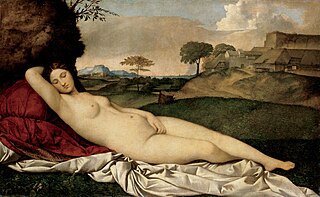 W
WThe Sleeping Venus, also known as the Dresden Venus, is a painting traditionally attributed to the Italian Renaissance painter Giorgione, although it has long been usually thought that Titian completed it after Giorgione's death in 1510. The landscape and sky are generally accepted to be mainly by him. In the 21st century, much scholarly opinion has shifted further, to see the nude figure of Venus as also painted by Titian, leaving Giorgione's contribution uncertain. It is in the Gemäldegalerie, Dresden. After World War II, the painting was briefly in possession of the Soviet Union.
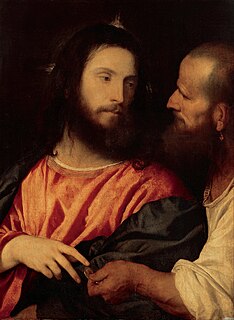 W
WThe Tribute Money is a panel painting in oils of 1516 by the Italian late Renaissance artist Titian, now in the Gemäldegalerie Alte Meister in Dresden, Germany. It depicts Christ and a Pharisee at the moment in the Gospels when Christ is shown a coin and says "Render unto Caesar the things that are Caesar's, and unto God the things that are God's". It is signed "Ticianus F.[ecit]", painted on the trim of the left side of the Pharisee's collar.
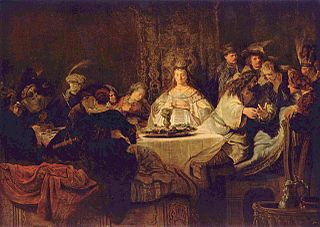 W
WThe Wedding Feast of Samson is a 1638 oil on canvas painting by Rembrandt. It was acquired for his collection in Dresden by Augustus II of Poland. It first appeared in that collection's inventory in 1722-1728 and is now in the Gemäldegalerie Alte Meister.
 W
WThe Wild Boar Hunt is a 1618-1620 oil on oak panel painting by Peter Paul Rubens, now in the Gemäldegalerie Alte Meister in Dresden.
 W
WYoung Woman in a Pearl Necklace is an oil on canvas painting by the Dutch painter Willem Drost. It is an example of Dutch Golden Age painting and is part of the collection of Gemäldegalerie Alte Meister.